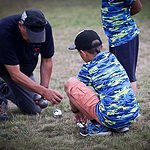So, you think making cornhole bags is as simple as tossing a beanbag into a hole? Think again. Crafting these essential game pieces requires precision and skill.
From selecting the right fabric to the meticulous filling process, every step contributes to the perfect cornhole experience.
But how exactly do you ensure your bags are up to the challenge? Stay tuned to discover the secrets that will elevate your cornhole game to the next level.
Key Takeaways
- Select durable fabrics like Nimbus Cotton Duck for longevity.
- Double stitch with Tex 70 Polyester Thread for strength.
- Fill bags with plastic corn pellets for regulation weight.
- Utilize precise cutting and stitching techniques for quality cornhole bags.
Materials Needed for Cornhole Bags
To make high-quality cornhole bags, you'll need specific materials that are crucial for ensuring durability and performance during gameplay. Start by selecting durable Nimbus Cotton Duck fabric, which is recommended for its strength.
When cutting the fabric squares, precision is key to ensure uniformity in size. Utilize Tex 70 Polyester Thread and Size #18 Round/Sharp Point Needles when using the sewing machine to stitch the fabric squares together securely.
Remember to leave a small opening to fill the bags with plastic corn pellets, a common choice for bag fillers due to their weight and durability. Once filled, carefully stitch the opening closed to prevent spillage during play.
These steps, along with essential tools like fabric scissors, a ruler, and a marking tool, will help you create cornhole bags that are sturdy and able to withstand the rigors of the game.
Selecting the Right Fabric
Considering the longevity and performance of your cornhole bags, have you thought about the durability of the fabric you select? To ensure your DIY Cornhole bags withstand countless games, it's crucial to choose a sturdy fabric like 10-12 oz duck cloth. This fabric is renowned for its resilience and ability to resist wear and tear, making it an ideal choice for your project. Additionally, using a fabric stiffener such as Mod Podge Stiffy can further enhance the durability and help maintain the shape of the bags over time. When sewing the bags together, opt for coordinating thread that matches the fabric to achieve a professional look. Avoid lightweight fabrics that may easily tear during gameplay, as you want your cornhole bags to be able to endure hours of fun without falling apart. By selecting the right fabric and utilizing your sewing skills effectively, you can create high-quality cornhole bags that will last for years to come.
| Fabric Type | Benefits | Usage |
|---|---|---|
| Duck Cloth | Sturdy and durable fabric | Ideal for bags |
| Cotton | Comfortable and easy to work with | Linings |
| Polyester Blend | Water-resistant and quick-drying | Outdoor play |
Cutting the Fabric Squares
When cutting the fabric squares for your cornhole bags, precision is key to ensuring consistent size and durability throughout the gameplay. To achieve this, follow these essential steps:
- Measure Twice, Cut Once: Cut fabric squares into precise 7×7 inch pieces for standard size cornhole bags.
- Tools of the Trade: Utilize a rotary cutter, ruler, and cutting mat to ensure accurate and clean cuts for your fabric squares.
- Consistency is Key: Maintain accuracy in cutting to guarantee uniformity in bag size and weight for fair gameplay.
- Durability Matters: Opt for sturdy and durable fabric squares that can withstand the tossing and rough handling during cornhole games.
Sewing the Bags Together
For assembling the cornhole bags, ensure you have your sewing machine ready with both straight and zig-zag stitching capabilities. Using a sturdy cotton fabric is recommended for durability. Start by placing two fabric squares with their right sides facing each other. Sew around the edges with a 1/2 inch seam allowance, leaving one side open for turning and filling. Double stitching along the seams will provide extra strength, especially during vigorous gameplay.
When sewing, pay attention to precision to prevent any bursting of the bags. The double stitch will secure the seams tightly, ensuring the bags can withstand frequent use. Make sure to backstitch at the beginning and end of each seam to secure the stitches in place. This meticulous approach will result in professionally finished cornhole bags that are both aesthetically pleasing and robust.
Once the bags are sewn and turned inside out, they're ready to be filled with pellets for the perfect weight and feel during gameplay.
Leaving a Turning Hole
To create a turning hole for filling the cornhole bags, carefully select a strategic location on one side of the fabric square. When leaving a turning hole, ensure it's large enough to comfortably flip the bags inside out for filling but not too large that it compromises the structural integrity of the bag.
Here are some essential steps to consider:
- Strategic Placement: Choose a spot on one side of the bag that allows easy access to fill the bags with corn or pellets.
- Seam Allowance: Sew around the turning hole with a small seam allowance to provide room for a secure closing after filling.
- Secure Closing: After filling the bags, make sure to securely close the turning hole to prevent any spillage of the filling.
- Using Pins or Clips: Utilize pins or clips to temporarily close the turning hole while filling the bags to maintain control over the process.
Final Stitching for Durability
Ensuring the finalized double stitching on the inner sides of the cornhole bags is impeccably executed contributes significantly to their overall durability and longevity. When conducting the final stitching for durability, it's crucial to use a strong nylon thread that can withstand heavy use. This type of thread provides the necessary strength to keep the bags intact during gameplay. The final stitching process should be approached with precision and care to prevent any grains from leaking out of the bags, ensuring they maintain their proper weight and feel.
A tight and secure final stitch is essential not only for the bags' longevity but also to meet regulation standards for cornhole gameplay. Regulations often mandate specific stitching requirements to ensure fair play and consistent performance. By adhering to these standards and executing the final stitching meticulously, you can guarantee that your cornhole bags are durable, reliable, and ready for countless games.
Filling the Bags With Corn or Beans
Fill the cornhole bags with either 15-16 ounces of whole kernel corn or synthetic corn pellets to achieve the standard weight. To ensure your bags are evenly filled and meet the required weight for optimal gameplay, follow these steps:
- Measure Precisely: Utilize a digital scale to accurately measure the amount of filling for each bag.
- Even Distribution: Distribute the corn or beans evenly within the bag to maintain consistent weight and balance.
- Avoid Overfilling: Be cautious not to overfill the bags, as this can lead to bursting and impact the game performance.
- Verify Weight: After filling, weigh each bag again to confirm it meets the recommended weight range.
Closing the Fill Hole Securely
How can you ensure the secure closure of the fill hole on your cornhole bags?
To close the fill hole securely, use a strong nylon thread for stitching. Start by sewing around the fill hole with precise and secure stitching, ensuring that the thread is tightly woven to prevent any filler from escaping during use. A zig-zag stitch is recommended for added strength and durability in securing the fill hole closed. It's also advisable to double stitch the closure for extra reinforcement, further securing the contents inside the bag.
After stitching, trim any excess fabric around the fill hole to create a neat and tidy finish. This step not only enhances the appearance of the cornhole bag but also prevents any loose threads from unraveling over time. By following these steps and paying attention to detail, you can confidently ensure that the fill hole on your cornhole bags is closed securely, ready for countless rounds of gameplay.
Inspecting the Finished Cornhole Bags
After meticulously closing the fill hole on your cornhole bags with strong nylon thread and double stitching for reinforcement, the next step is to inspect the finished bags for quality assurance.
Things to Inspect in Your Cornhole Bags:
- Weight: Ensure each bag falls within the 15.5-16.5 ounce range for fair gameplay.
- Stitching: Check for double lines of stitching to guarantee durability during intense matches.
- Closure: Examine the closure method, whether it's a topstitch or ladder stitch, to secure the contents inside.
- Fabric: Verify there are no holes or weak spots in the fabric to prevent any issues during use.
Additional DIY Cornhole Bag Tips
For enhanced durability and performance, consider incorporating additional reinforcements in your DIY cornhole bags. Start by using durable 10 oz canvas duck cloth for longevity and resilience.
Double stitching the bags is crucial to prevent bursting and ensure durability during intense cornhole gameplay. To maintain consistent weight and performance, fill the bags with synthetic corn or recycled plastic resin pellets.
When constructing the bags, make sure to use a sewing machine with straight and zig-zag stitches capability for efficient and secure stitching. Following the proper regulations, each cornhole bag should weigh between 15.5-16.5 ounces to ensure fair gameplay.





